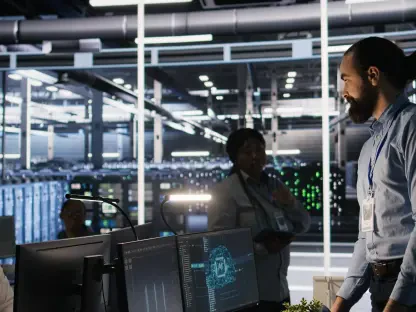In an era marked by escalating cyber threats targeting national assets, the Federal Cybersecurity Strategy stands as a cornerstone in safeguarding the United States’ critical infrastructure. Amidst continuous nation-state attacks, ensuring a robust defense through a comprehensive and adaptive cybersecurity strategy is paramount. Erica Banks, Vice President at Booz Allen Hamilton, offers key insights into this intricate landscape, highlighting areas ripe for development and enhancement.
The Need for Operational Collaboration
Synchronizing Offensive and Defensive Operations
Operational collaboration has emerged as a crucial element in the Federal Cybersecurity Strategy. By synchronizing offensive and defensive maneuvers across federal agencies, the government can build a more unified and resilient defense posture. This entails real-time sharing of anonymized insights from offensive cyber operations to bolster defensive strategies. Effective collaboration helps in identifying potential threats before they evolve into significant breaches, thereby enhancing overall cybersecurity.
Synchronizing operations also means that agencies must adopt advanced technologies that facilitate rapid data sharing and analysis. The collaboration involves not just the technical exchange of information but also the unification of protocols and methodologies. Agencies must agree on standard operating procedures to ensure that data is interpreted consistently and effectively across the board. Such standardization is crucial for maintaining a proactive stance against threats, as it ensures that valuable intelligence is not lost in translation between different entities.
Enhancing Interagency Cooperation
Interagency cooperation is essential for creating a seamless cybersecurity framework. When various federal entities work in silos, it hinders the ability to respond swiftly to cyber incidents. Enhancing cooperation requires establishing clear communication channels and protocols for sharing critical information. It also involves conducting joint training exercises to simulate potential cyberattacks, enabling agencies to practice coordinated responses. This approach fosters a culture of collective security across the federal landscape.
Effective interagency cooperation also necessitates the establishment of centralized command and control centers that can oversee joint operations. Centralizing efforts helps in streamlining decision-making processes and ensures that all participating agencies are aligned in their strategic initiatives. Additionally, fostering a culture of transparency and trust among agencies is imperative. By building strong relationships and mutual respect, agencies can work together more cohesively, thus enhancing the federal government’s overall cybersecurity posture.
Funding and Resource Allocation
Challenges of Irregular Funding
One of the primary obstacles in implementing a robust cybersecurity strategy is the challenge of irregular and unpredictable funding. Federal agencies often struggle to maintain a proactive defense posture due to sporadic financial support. Consistent and sustainable funding is imperative for investing in advanced cybersecurity measures and technologies. This stability allows agencies to focus on long-term defense strategies instead of resorting to piecemeal, reactive solutions that only address immediate threats.
Irregular funding also hampers the ability to invest in critical infrastructure upgrades and human resources. Without predictable financial backing, agencies may be forced to delay or cancel essential projects, leaving vulnerabilities unchecked. To overcome these challenges, it’s crucial for policymakers to recognize the importance of allocating funds systematically, securing multi-year budgets that facilitate ongoing improvements. Only through sustained investment can the U.S. build a resilient cybersecurity framework capable of withstanding sophisticated and persistent threats.
Sustained Investments for Proactive Measures
Investing in cybersecurity infrastructure and resources on a sustained basis ensures that the U.S. stays ahead of emerging threats. Proactive measures include deploying state-of-the-art security systems, conducting regular vulnerability assessments, and investing in research and development of new technologies. Continuous investment enables federal agencies to adapt to the ever-changing cyber threat landscape, making it more difficult for adversaries to exploit vulnerabilities.
Sustained investment also allows for the nurturing of cybersecurity innovation ecosystems. By funding public-private partnerships and encouraging collaboration between government entities and tech companies, the federal government can accelerate the deployment of next-generation security solutions. This collaborative environment not only enhances the efficacy of cybersecurity measures but also spurs advancements that can benefit the private sector, thereby strengthening national resilience on multiple fronts.
Leveraging Technology and Innovation
Utilizing Other Transaction Authorities (OTAs)
Leveraging technological advancements is a critical aspect of the federal cybersecurity strategy. The use of Other Transaction Authorities (OTAs) allows agencies to pilot innovative solutions that can be scaled across the Federal Civilian Executive Branch (FCEB) agencies. OTAs facilitate agile procurement processes, enabling faster deployment of cutting-edge technologies. This approach not only enhances cybersecurity capabilities but also spurs innovation within the industry.
By utilizing OTAs, federal agencies can bypass traditional, often cumbersome, procurement procedures that can delay the implementation of critical technologies. This agility is particularly crucial in the cybersecurity domain, where the threat landscape evolves rapidly. Engaging in OTAs allows for rapid testing and validation of new technologies, ensuring that the most effective solutions are deployed swiftly. Furthermore, such an approach encourages a competitive environment among technology providers, driving continuous innovation and improvement in cybersecurity tools and practices.
The Role of AI in Cybersecurity
Artificial Intelligence (AI) plays a pivotal role in enhancing cybersecurity defenses. AI can analyze vast amounts of data to detect anomalies and potential threats more efficiently than human analysts alone. By integrating AI into cybersecurity frameworks, federal agencies can predict and mitigate attacks before they cause significant damage. AI-driven solutions also help in automating routine tasks, allowing cybersecurity professionals to focus on complex, high-priority threats.
AI also enhances the ability to respond to zero-day vulnerabilities and emerging threat vectors by providing real-time analytics and automated responses. Machine learning algorithms can continuously evolve by learning from new data, thereby improving their threat detection capabilities over time. Additionally, AI can assist in post-incident analysis by quickly sifting through logs and reports to identify the root cause and scope of an attack, facilitating faster recovery and strengthening defenses against future intrusions.
Balancing Compliance and Operational Efficiency
Navigating Executive Order 14028
With the introduction of regulations like Executive Order 14028, federal agencies face the challenge of balancing compliance requirements while maintaining operational efficiency. This directive mandates stringent cybersecurity standards, compelling agencies to adopt measures such as multi-factor authentication and encryption. While ensuring compliance is vital, it is equally important to align these requirements with operational goals to prevent disruptions in day-to-day activities.
Compliance with such regulatory mandates requires comprehensive planning and strategy alignment. Agencies must develop metric-based goals that can track both compliance and operational performance. This includes not only meeting the minimum security requirements but also exceeding them through proactive measures. Aligning these tasks with mission objectives ensures that cybersecurity initiatives support broader operational goals without causing bottlenecks or inefficiencies. This dual focus on compliance and functionality is crucial for maintaining a secure and efficient federal infrastructure.
Aligning Innovation with Regulatory Frameworks
Aligning innovation with compliance frameworks demands a strategic approach. Federal agencies need to set metric-based goals that foster innovation while adhering to regulatory standards. This involves leveraging existing insights and best practices to create streamlined processes that meet compliance requirements without compromising operational efficiency. Engaging with industry stakeholders and adopting a flexible, adaptive mindset are key to achieving this balance.
Innovation must be approached with a compliance-first mindset, ensuring that new technologies and processes do not inadvertently introduce new vulnerabilities. Federal agencies can achieve this by incorporating compliance checks at every stage of the development and deployment lifecycle. Engaging with industry experts and stakeholders helps in understanding the latest compliance trends and innovations, allowing agencies to adopt best practices. A dynamic, forward-thinking approach ensures that compliance does not stifle innovation but rather complements it, fostering a resilient cybersecurity posture.
Talent Recruitment and Retention
Addressing Cybersecurity Talent Shortage
The shortage of skilled cybersecurity professionals is a significant challenge for federal agencies. Recruiting and retaining talent requires innovative approaches that go beyond traditional hiring practices. Skills-based assessments can help identify candidates with the right expertise, while offering competitive salaries and career development opportunities can attract top talent. Additionally, fostering a positive work environment that emphasizes teamwork, continuous learning, and professional growth is essential for retention.
To address the talent shortage, federal agencies can collaborate with educational institutions to create specialized training programs that cater to the unique demands of the cybersecurity field. Initiatives like internships, apprenticeships, and fellowship programs can provide hands-on experience for aspiring professionals, ensuring a steady pipeline of skilled workers. Additionally, creating clear career progression paths within federal agencies can make cybersecurity roles more attractive, encouraging long-term commitment and reducing turnover rates. This holistic approach to talent management addresses immediate needs while laying the groundwork for sustained expertise in the years to come.
Mitigating Burnout and Leveraging AI
Cybersecurity professionals often face high levels of stress and burnout due to the demanding nature of their work. To mitigate burnout, it is crucial to reduce cognitive overload by optimizing toolsets and automating routine tasks through AI. Leveraging AI not only enhances efficiency but also allows cyber professionals to focus on strategic, high-impact activities. Implementing wellness programs and encouraging work-life balance can further help in retaining skilled personnel.
AI-driven automation can take over tedious and repetitive tasks, such as monitoring network activity and generating incident reports, freeing up human analysts for more critical and intellectually stimulating work. This not only improves job satisfaction but also enhances overall operational efficiency. Additionally, offering mental health resources and fostering a supportive work culture can help mitigate the pressures that lead to burnout. By creating an environment where cybersecurity professionals feel valued and supported, federal agencies can ensure a motivated and resilient workforce capable of defending against sophisticated cyber threats.
Risk Management Maturity
Evaluating Risk Management Frameworks
Evaluating the maturity of risk management frameworks is vital for ensuring a resilient cybersecurity strategy. Federal agencies must conduct regular assessments to identify gaps and weaknesses in their existing frameworks. This involves adopting a dynamic approach to risk management that can adapt to the evolving threat landscape. By continually refining their risk management practices, agencies can better anticipate and mitigate potential threats.
Comprehensive risk assessments should include a thorough analysis of both internal and external factors that could impact the agency’s cybersecurity posture. This includes evaluating the effectiveness of current controls, identifying emerging threats, and planning for various scenarios to ensure resilience. Agencies should adopt a continuous improvement mindset, using audit findings and incident reports to inform and enhance their risk management frameworks. Regular training and awareness programs can also bolster an agency’s overall risk posture, ensuring that all personnel are prepared and vigilant against potential threats.
Planning for Resiliency in Case of Breaches
In an age marked by rising cyber threats aimed at the nation’s vital assets, the Federal Cybersecurity Strategy serves as a critical safeguard for the United States’ essential infrastructure. With continuous attacks from nation-states, it is crucial to maintain a strong defense through a comprehensive and adaptable cybersecurity strategy. Erica Banks, Vice President at Booz Allen Hamilton, provides valuable insights into this complex environment. She identifies key areas that are primed for development and enhancement, emphasizing the importance of staying ahead of sophisticated cyber adversaries. The strategy must evolve to address ever-changing threats and adapt to new vulnerabilities. Banks underlines the need for collaboration between the public and private sectors to fortify our defenses. By investing in cutting-edge technologies, fostering a culture of cybersecurity awareness, and promoting proactive measures, the Federal Cybersecurity Strategy aims to build a resilient defense system. As the digital landscape continues to evolve, this strategy remains a crucial element in protecting the country’s critical infrastructure from cyberattacks.









